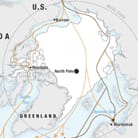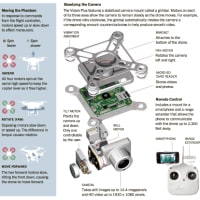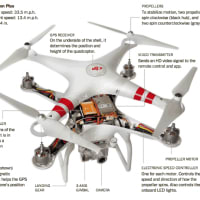Arctic Ice Hits Near-Record Low, Threatening Wildlife 北極海の氷の記録的減少が野生動物を脅かしている。
温暖化のスピードは想像以上に加速している。
by Richard Harris

Ice on the Arctic Ocean has melted to its second-lowest level on record. Above, ice in a fjord in Greenland. 北極海の氷が記録上二番目のレベルまで溶けている。上の写真はグリーンランドのフィヨルドの氷。
September 16, 2011
Ice on the Arctic Ocean has melted to its second-lowest level on record, according to researchers in Colorado who track this trend. The summertime melt coincides with a dramatic warming over the past decade, and it's already affecting wildlife in the Arctic Ocean.
この温暖化傾向を追跡しているコロラドの研究者によると、北極海の氷が記録上二番目の低水準まで溶けている。 夏季の溶融は、この10年にわたる劇的な温暖化と同時に起こり、既に北極の生き物にも影響を与え始めている。
On Thin Ice
This year, the amount of Arctic sea ice hit its second-lowest levels since record-keeping began in 1979. The chart below shows the amount of Arctic ice, in millions of square miles, since 2007.
今年、北極海の氷の量は1979年の記録開始から二番目に低い水準になった。下のグラフは2007年以来の北極海の氷の量を示している。 (単位:100万平方マイル)

Source: National Snow and Ice Data Center
Credit: Nelson Hsu/NPR
The Arctic ice comes and goes with the seasons; typically about half of the wintertime ice melts away by mid-September. After that low-point, the ice regrows. In 2007, the amount of ice left in September hit a dramatic low.
北極の氷は季節によって往ったり来たりしている。 いつもは冬季の氷の約半分は9月中旬までに溶けてしまう。 そして、その最低点から、再び氷は成長していく。2007年には9月に残っている氷の量が劇的に低下した。Mark Serreze, who heads the National Snow and Ice Data Center in Colorado, says this year's low is not far off that 2007 record.
マーク・セレッズはコロラドのナショナル・スノー・アイスデータセンターの長をしているが、今年の最低点は2007年の記録ほど酷くはないと言っている。
"What it's telling us is that the long-term decline in Arctic sea ice is continuing, and even appears to be accelerating at this point," he says.
「この変化が我々に示しているのは北極海の氷の長期にわたる減少が今も続いているということ、そして現時点で加速さえしているということです。」と彼は言う。
Serreze says what's notable about this year is how different the weather was, compared with the record-low year in 2007.
セレッズは今年の特徴的なことは2007年の最低の年と比べて、如何に気候が異なっていたかということだと言う。"In 2007, one of the big reasons we got to a record low is because we essentially had a near-perfect weather pattern that pumped a lot of warm air into the Arctic," Serreze says.
「2007年には、記録的な低水準になった、最も大きな理由は、北極に温かい空気を沢山生み出す典型的な天候のパターンだったことです。」
Unusually cloud-free skies hastened the melting, and wind patterns made the ice prone to disappear. Serreze says this year's melt was nearly as bad, but without the extreme weather.
異常なほど雲一つない青空が氷の融解を促進し、風向きのパターンが氷を消失させました。しかし、今年の溶融は2007年に相当する溶融であるにも関わらず、天候は2007年のような極端な天気ではなかったのです。
"That's telling us that sea ice is really in trouble," he says. "The ice is so thin now that it just can't take a hit in summer anymore."
「このことは、問題が海氷それ自体が本当に問題で、その氷が今は本当に薄くなっており、夏に打撃を受けるということはもはや無いのです。」That's setting up a vicious cycle. There's no question that the Arctic Ocean will freeze up again over the fall and winter, but there's less and less really thick ice building back up year to year.
これは悪循環となりつつあります。 北極海が秋と冬に再び結氷するのは疑う余地のないところですが、その氷の厚さが年々本当に薄くなっているのです。
"Come next spring, we're just going to have a lot of thin ice that formed over the autumn and winter. That's the stuff that melts out easily the next summer," Serreze says. "So there's a feedback at work here, and that feedback is getting stronger with time."
「来春になると、私たちは秋と冬に結氷した沢山の薄い氷を迎えることになるでしょう。 これは夏には容易に溶けてしまうような氷です。 ここで起きるのは、そのフィードバックであり、そのフィードバックは回を重ねるごとに強化されます。」

INTERACTIVE
The Arctic's Diminishing Sea Ice 北極海の縮みゆく海氷
Serreze says the Arctic could be ice-free in the summer by about 2030, though that is hard to predict; other scientists say it could be mid-century before that dramatic point is reached.
セレッズは、予測は困難だが、2030年頃までの夏には北極は氷のない海になっているかもしれないという。 他の科学者は、そのような劇的なポイントは今世紀中頃とみている。
Why does this matter? Ice that's floating on the sea surface doesn't raise the sea level when it melts. But researchers suspect it will alter the weather that reaches us far to the south. It's already affecting Arctic wildlife.
何故、これが問題なのか? 海洋上に浮いている氷がとけても、海水面を上昇させることにはならないが、多くの研究者は南方の相当遠くまで気候変動に影響を及ぼすのではないかとみている。 また、それは北極の生物にも事実影響を及ぼす。
Thousands of walruses that usually float around on sea ice and dive down to feed on the ocean floor abandoned those floes when the only ice left off the coast of Alaska was over water that was too deep.
何千頭ものセイウチは、海上部の氷が十分に重い時にだけ、アラスカの海岸から離岸する氷山からちぎれた海氷に載って漂いながら、そこから潜って海底の餌をとっている。
"After the sea ice ran out, a lot of the walruses came to the shore of northwest Alaska and began hauling out there," says Chad Jay, a research ecologist with the U.S. Geological Survey in Alaska. He says it's harder on the walruses to feed from shore, because they have to swim farther to get back to their food supply. It's also more hazardous for them to be up on the rocks instead of on ice, he says.
「海氷が消滅した後では、 多くのセイウチはアラスカの北西海岸に来て、そこに留まるでしょう。」とアラスカの米国地理探査の生態研究者チャド・ジェイは言う。 セイウチにとって海岸から餌をとるのは困難だ、なぜなら餌を取りつづけるためにより遠くまで泳がねばならなくなるからだ、それに上陸するときに氷ではなく、岩の上に飛び乗るのは非常に危険だ。
"When they're hauled out in these large aggregations on the shore, if there's a disturbance or something that causes walruses to flee into the water quickly, then quickly the calves get run over and die as a result," Jay says.
He's now trying to figure out how the walruses will adapt as the sea ice continues to melt away.
「彼らが、大きな集団として海岸に留まると、もし何かの拍子で混乱が起き、セイウチが一斉に海に逃げ出すようなことになった場合、子供は圧殺されるだろう。」とジェイは言う。 海氷が溶けて続けているなかで、どのようにしてセイウチは適応していくのか彼は明らかにしようとしている。
温暖化のスピードは想像以上に加速している。
by Richard Harris

Ice on the Arctic Ocean has melted to its second-lowest level on record. Above, ice in a fjord in Greenland. 北極海の氷が記録上二番目のレベルまで溶けている。上の写真はグリーンランドのフィヨルドの氷。
September 16, 2011
Ice on the Arctic Ocean has melted to its second-lowest level on record, according to researchers in Colorado who track this trend. The summertime melt coincides with a dramatic warming over the past decade, and it's already affecting wildlife in the Arctic Ocean.
この温暖化傾向を追跡しているコロラドの研究者によると、北極海の氷が記録上二番目の低水準まで溶けている。 夏季の溶融は、この10年にわたる劇的な温暖化と同時に起こり、既に北極の生き物にも影響を与え始めている。
On Thin Ice
This year, the amount of Arctic sea ice hit its second-lowest levels since record-keeping began in 1979. The chart below shows the amount of Arctic ice, in millions of square miles, since 2007.
今年、北極海の氷の量は1979年の記録開始から二番目に低い水準になった。下のグラフは2007年以来の北極海の氷の量を示している。 (単位:100万平方マイル)

Source: National Snow and Ice Data Center
Credit: Nelson Hsu/NPR
The Arctic ice comes and goes with the seasons; typically about half of the wintertime ice melts away by mid-September. After that low-point, the ice regrows. In 2007, the amount of ice left in September hit a dramatic low.
北極の氷は季節によって往ったり来たりしている。 いつもは冬季の氷の約半分は9月中旬までに溶けてしまう。 そして、その最低点から、再び氷は成長していく。2007年には9月に残っている氷の量が劇的に低下した。Mark Serreze, who heads the National Snow and Ice Data Center in Colorado, says this year's low is not far off that 2007 record.
マーク・セレッズはコロラドのナショナル・スノー・アイスデータセンターの長をしているが、今年の最低点は2007年の記録ほど酷くはないと言っている。
"What it's telling us is that the long-term decline in Arctic sea ice is continuing, and even appears to be accelerating at this point," he says.
「この変化が我々に示しているのは北極海の氷の長期にわたる減少が今も続いているということ、そして現時点で加速さえしているということです。」と彼は言う。
Serreze says what's notable about this year is how different the weather was, compared with the record-low year in 2007.
セレッズは今年の特徴的なことは2007年の最低の年と比べて、如何に気候が異なっていたかということだと言う。"In 2007, one of the big reasons we got to a record low is because we essentially had a near-perfect weather pattern that pumped a lot of warm air into the Arctic," Serreze says.
「2007年には、記録的な低水準になった、最も大きな理由は、北極に温かい空気を沢山生み出す典型的な天候のパターンだったことです。」
Unusually cloud-free skies hastened the melting, and wind patterns made the ice prone to disappear. Serreze says this year's melt was nearly as bad, but without the extreme weather.
異常なほど雲一つない青空が氷の融解を促進し、風向きのパターンが氷を消失させました。しかし、今年の溶融は2007年に相当する溶融であるにも関わらず、天候は2007年のような極端な天気ではなかったのです。
"That's telling us that sea ice is really in trouble," he says. "The ice is so thin now that it just can't take a hit in summer anymore."
「このことは、問題が海氷それ自体が本当に問題で、その氷が今は本当に薄くなっており、夏に打撃を受けるということはもはや無いのです。」That's setting up a vicious cycle. There's no question that the Arctic Ocean will freeze up again over the fall and winter, but there's less and less really thick ice building back up year to year.
これは悪循環となりつつあります。 北極海が秋と冬に再び結氷するのは疑う余地のないところですが、その氷の厚さが年々本当に薄くなっているのです。
"Come next spring, we're just going to have a lot of thin ice that formed over the autumn and winter. That's the stuff that melts out easily the next summer," Serreze says. "So there's a feedback at work here, and that feedback is getting stronger with time."
「来春になると、私たちは秋と冬に結氷した沢山の薄い氷を迎えることになるでしょう。 これは夏には容易に溶けてしまうような氷です。 ここで起きるのは、そのフィードバックであり、そのフィードバックは回を重ねるごとに強化されます。」

INTERACTIVE
The Arctic's Diminishing Sea Ice 北極海の縮みゆく海氷
Serreze says the Arctic could be ice-free in the summer by about 2030, though that is hard to predict; other scientists say it could be mid-century before that dramatic point is reached.
セレッズは、予測は困難だが、2030年頃までの夏には北極は氷のない海になっているかもしれないという。 他の科学者は、そのような劇的なポイントは今世紀中頃とみている。
Why does this matter? Ice that's floating on the sea surface doesn't raise the sea level when it melts. But researchers suspect it will alter the weather that reaches us far to the south. It's already affecting Arctic wildlife.
何故、これが問題なのか? 海洋上に浮いている氷がとけても、海水面を上昇させることにはならないが、多くの研究者は南方の相当遠くまで気候変動に影響を及ぼすのではないかとみている。 また、それは北極の生物にも事実影響を及ぼす。
Thousands of walruses that usually float around on sea ice and dive down to feed on the ocean floor abandoned those floes when the only ice left off the coast of Alaska was over water that was too deep.
何千頭ものセイウチは、海上部の氷が十分に重い時にだけ、アラスカの海岸から離岸する氷山からちぎれた海氷に載って漂いながら、そこから潜って海底の餌をとっている。
"After the sea ice ran out, a lot of the walruses came to the shore of northwest Alaska and began hauling out there," says Chad Jay, a research ecologist with the U.S. Geological Survey in Alaska. He says it's harder on the walruses to feed from shore, because they have to swim farther to get back to their food supply. It's also more hazardous for them to be up on the rocks instead of on ice, he says.
「海氷が消滅した後では、 多くのセイウチはアラスカの北西海岸に来て、そこに留まるでしょう。」とアラスカの米国地理探査の生態研究者チャド・ジェイは言う。 セイウチにとって海岸から餌をとるのは困難だ、なぜなら餌を取りつづけるためにより遠くまで泳がねばならなくなるからだ、それに上陸するときに氷ではなく、岩の上に飛び乗るのは非常に危険だ。
"When they're hauled out in these large aggregations on the shore, if there's a disturbance or something that causes walruses to flee into the water quickly, then quickly the calves get run over and die as a result," Jay says.
He's now trying to figure out how the walruses will adapt as the sea ice continues to melt away.
「彼らが、大きな集団として海岸に留まると、もし何かの拍子で混乱が起き、セイウチが一斉に海に逃げ出すようなことになった場合、子供は圧殺されるだろう。」とジェイは言う。 海氷が溶けて続けているなかで、どのようにしてセイウチは適応していくのか彼は明らかにしようとしている。




















※コメント投稿者のブログIDはブログ作成者のみに通知されます